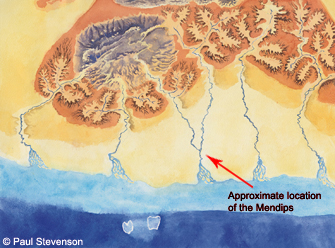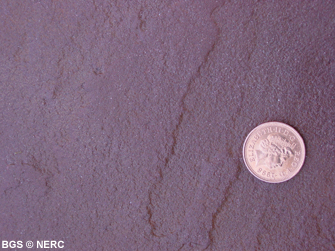
Ancient environments
Silurian l Devonian l Carboniferous l Triassic l Jurassic
The Devonian, 385 – 359 million years ago

Earth movements at the end of the Silurian saw the final closure of the Iapetus Ocean that had separated northern and southern Britain. With the final elimination of the sea from most of the UK, and the creation of mountain chains across Scotland, Wales and Northern England, Britain was now part of a semi-arid continental landmass.
In the Mendips, only the youngest part of the Devonian is represented in the rock succession. The thick sandstones, pebbly sandstones and mudstones of the Portishead Formation were laid down by meandering river systems at the southern margin of a large landmass. The sea covered southern England south of the Mendips.

During the Devonian land plants evolved, and the microscopic spores they produced are sometimes found as fossils. Towards the top of the largely unfossiliferous Devonian succession in the Mendips, there are the remains of plants and fish, heralding the dramatic change in environment that occurred across the region at the beginning of the Carboniferous.
- Home
- Overview maps
- Locality
areas
- Cheddar Gorge
- Charterhouse
- Blackdown
- Burrington Combe
- Shipham & Rowberrow
- Crook Peak & Axbridge
- Banwell to Churchill
- Priddy
- Harptree & Smitham Hill
- Draycott & Westbury-sub-Mendip
- Wookey Hole & Ebbor Gorge
- Wells
- Great Elm & Vallis Vale
- Mells & the Wadbury Valley
- The Vobster area
- The Whatley area
- Torr Works & Asham Wood
- Beacon Hill
- Stoke St Michael & Oakhill
- Holwell & Nunney
- Shepton Mallet & Maesbury
- Gurney Slade & Emborough
- The Nettlebridge valley
- Geology
- Minerals and mines
- Quarrying
- Caves and karst
- Biodiversity
- Detailed site information
- Acknowledgements
- External links
- Search
- Site map